初中英语案例分析
- 格式:doc
- 大小:37.00 KB
- 文档页数:6
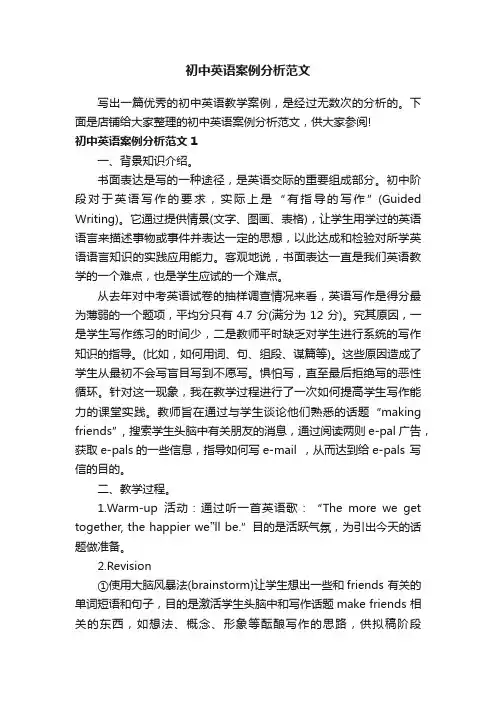
初中英语案例分析范文写出一篇优秀的初中英语教学案例,是经过无数次的分析的。
下面是店铺给大家整理的初中英语案例分析范文,供大家参阅!初中英语案例分析范文1一、背景知识介绍。
书面表达是写的一种途径,是英语交际的重要组成部分。
初中阶段对于英语写作的要求,实际上是“有指导的写作”(Guided Writing)。
它通过提供情景(文字、图画、表格),让学生用学过的英语语言来描述事物或事件并表达一定的思想,以此达成和检验对所学英语语言知识的实践应用能力。
客观地说,书面表达一直是我们英语教学的一个难点,也是学生应试的一个难点。
从去年对中考英语试卷的抽样调查情况来看,英语写作是得分最为薄弱的一个题项,平均分只有4.7分(满分为12分)。
究其原因,一是学生写作练习的时间少,二是教师平时缺乏对学生进行系统的写作知识的指导。
(比如,如何用词、句、组段、谋篇等)。
这些原因造成了学生从最初不会写盲目写到不愿写。
惧怕写,直至最后拒绝写的恶性循环。
针对这一现象,我在教学过程进行了一次如何提高学生写作能力的课堂实践。
教师旨在通过与学生谈论他们熟悉的话题“making friends”, 搜索学生头脑中有关朋友的消息,通过阅读两则e-pal广告,获取e-pals的一些信息,指导如何写e-mail ,从而达到给e-pals 写信的目的。
二、教学过程。
1.Warm-up活动:通过听一首英语歌:“The more we get together, the happier we‟ll be.”目的是活跃气氛,为引出今天的话题做准备。
2.Revision①使用大脑风暴法(brainstorm)让学生想出一些和friends 有关的单词短语和句子,目的是激活学生头脑中和写作话题make friends 相关的东西,如想法、概念、形象等酝酿写作的思路,供拟稿阶段(drafting stage)选择有写的价值和意义的东西时参考。
]②根据下列所给提示介绍你的朋友(四人一小组活动)。
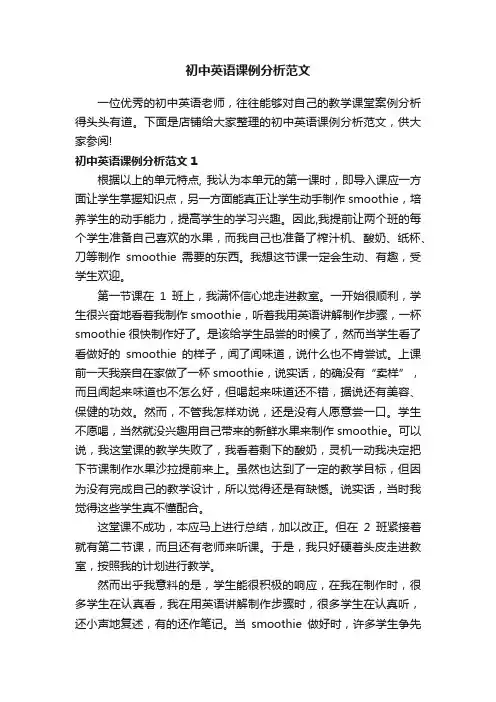
初中英语课例分析范文一位优秀的初中英语老师,往往能够对自己的教学课堂案例分析得头头有道。
下面是店铺给大家整理的初中英语课例分析范文,供大家参阅!初中英语课例分析范文1根据以上的单元特点, 我认为本单元的第一课时,即导入课应一方面让学生掌握知识点,另一方面能真正让学生动手制作smoothie,培养学生的动手能力,提高学生的学习兴趣。
因此,我提前让两个班的每个学生准备自己喜欢的水果,而我自己也准备了榨汁机、酸奶、纸杯、刀等制作smoothie需要的东西。
我想这节课一定会生动、有趣,受学生欢迎。
第一节课在1班上,我满怀信心地走进教室。
一开始很顺利,学生很兴奋地看着我制作smoothie,听着我用英语讲解制作步骤,一杯smoothie很快制作好了。
是该给学生品尝的时候了,然而当学生看了看做好的smoothie的样子,闻了闻味道,说什么也不肯尝试。
上课前一天我亲自在家做了一杯smoothie,说实话,的确没有“卖样”,而且闻起来味道也不怎么好,但喝起来味道还不错,据说还有美容、保健的功效。
然而,不管我怎样劝说,还是没有人愿意尝一口。
学生不愿喝,当然就没兴趣用自己带来的新鲜水果来制作smoothie。
可以说,我这堂课的教学失败了,我看着剩下的酸奶,灵机一动我决定把下节课制作水果沙拉提前来上。
虽然也达到了一定的教学目标,但因为没有完成自己的教学设计,所以觉得还是有缺憾。
说实话,当时我觉得这些学生真不懂配合。
这堂课不成功,本应马上进行总结,加以改正。
但在2班紧接着就有第二节课,而且还有老师来听课。
于是,我只好硬着头皮走进教室,按照我的计划进行教学。
然而出乎我意料的是,学生能很积极的响应,在我在制作时,很多学生在认真看,我在用英语讲解制作步骤时,很多学生在认真听,还小声地复述,有的还作笔记。
当smoothie做好时,许多学生争先恐后地要求品尝,引得听课的老师也要求品尝一下。
在轮到由学生自己边制作smoothie,边用英语介绍材料以及制作步骤时,很多学生都愿意上来试一试,而且做得也很好。
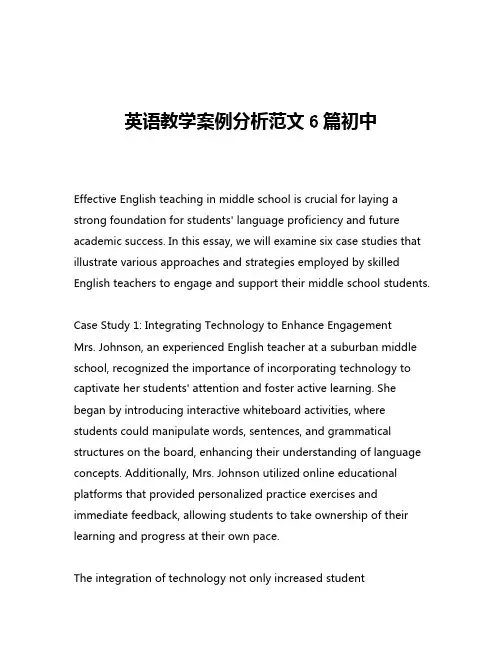
英语教学案例分析范文6篇初中Effective English teaching in middle school is crucial for laying a strong foundation for students' language proficiency and future academic success. In this essay, we will examine six case studies that illustrate various approaches and strategies employed by skilled English teachers to engage and support their middle school students.Case Study 1: Integrating Technology to Enhance Engagement Mrs. Johnson, an experienced English teacher at a suburban middle school, recognized the importance of incorporating technology to captivate her students' attention and foster active learning. She began by introducing interactive whiteboard activities, where students could manipulate words, sentences, and grammatical structures on the board, enhancing their understanding of language concepts. Additionally, Mrs. Johnson utilized online educational platforms that provided personalized practice exercises and immediate feedback, allowing students to take ownership of their learning and progress at their own pace.The integration of technology not only increased studentengagement but also enabled Mrs. Johnson to differentiate instruction and cater to diverse learning styles. Students who struggled with traditional pen-and-paper exercises found the digital activities more appealing and accessible, while those who thrived on independent learning benefited from the self-paced nature of the online resources. The result was a more dynamic and inclusive classroom environment, where all students felt empowered to participate and succeed in their English studies.Case Study 2: Fostering Critical Thinking through Literature Circles Mr. Patel, a middle school English teacher in a diverse urban setting, recognized the importance of developing his students' critical thinking skills. He implemented a literature circles approach, where students were divided into small groups and assigned different roles, such as discussion leader, connector, and literary analyst. Each group was responsible for reading a selected work of literature and engaging in collaborative discussions to unpack the themes, characters, and literary devices.The literature circles not only encouraged active engagement with the text but also cultivated essential communication and problem-solving skills. Students learned to listen actively, express their ideas clearly, and consider multiple perspectives. Mr. Patel's role shifted from a traditional lecturer to a facilitator, guiding the discussions and prompting students to delve deeper into the literary analysis.The success of this approach was evident in the students' increased confidence in expressing their interpretations and the depth of their literary analysis. Additionally, the collaborative nature of the literature circles fostered a sense of community and camaraderie among the students, further enhancing their overall learning experience.Case Study 3: Integrating Authentic Cultural ExperiencesIn a middle school with a growing population of English language learners, Ms. Garcia recognized the importance of incorporating authentic cultural experiences into her English lessons. She collaborated with the school's diversity committee to organize cultural celebrations and invite guest speakers from various backgrounds to share their stories and traditions.During these events, students had the opportunity to engage with the English language in a meaningful and contextual manner. They learned vocabulary and expressions related to the featured cultures, participated in interactive activities, and gained a deeper appreciation for the diversity within their school community. The cultural experiences also served as a platform for students to practice their speaking and listening skills in a low-stress, authentic setting.The integration of authentic cultural experiences not only improvedthe English language proficiency of the English language learners but also fostered a greater sense of inclusion and understanding among all students. The cross-cultural exchange and exposure to diverse perspectives enriched the learning environment and contributed to the overall growth and development of the students.Case Study 4: Differentiated Instruction for Struggling Readers Mrs. Nguyen, a middle school English teacher in a high-needs district, recognized the diverse learning needs of her students, particularly those who struggled with reading comprehension. She implemented a multi-tiered system of support, where she provided targeted interventions and differentiated instruction to address the individual needs of her students.For students who required additional support, Mrs. Nguyen utilized research-based reading strategies, such as guided reading, vocabulary development, and explicit instruction in phonics and fluency. She also incorporated the use of audiobooks, text-to-speech software, and graphic organizers to help struggling readers access the content and actively engage with the material.Mrs. Nguyen's dedication to differentiated instruction paid off, as her struggling readers demonstrated significant improvements in their reading abilities and overall academic performance. The individualized attention and tailored support not only boosted theirconfidence but also instilled a love for reading and learning.Case Study 5: Integrating Project-Based LearningMr. Goldstein, a middle school English teacher in a suburban setting, recognized the importance of making the English curriculum more relevant and engaging for his students. He implemented a project-based learning approach, where students were tasked with creating multimedia presentations on topics of their choice, ranging from social issues to literary analyses.The project-based learning approach allowed students to take an active role in their learning, as they conducted research, synthesized information, and utilized various technological tools to present their findings. Mr. Goldstein provided guidance and feedback throughout the process, ensuring that students developed essential skills, such as critical thinking, problem-solving, and effective communication.The project-based learning activities not only enhanced the students' engagement and motivation but also fostered their ability to collaborate, think creatively, and apply their knowledge to real-world situations. The final presentations showcased the students' diverse talents and perspectives, further enriching the learning environment.Case Study 6: Integrating Interdisciplinary ConnectionsMs. Lim, a middle school English teacher in a STEM-focused school,recognized the importance of integrating interdisciplinary connections to make the English curriculum more relevant and meaningful for her students. She collaborated with her colleagues from the science, mathematics, and social studies departments to develop cross-curricular lessons and projects.For example, in a unit on persuasive writing, Ms. Lim worked with the science teacher to have students research and write persuasive essays on environmental issues. The students not only honed their English language skills but also deepened their understanding of scientific concepts and their real-world applications. Similarly, in a poetry unit, Ms. Lim partnered with the art teacher to have students create visual representations of their poems, fostering their creativity and artistic expression.The integration of interdisciplinary connections not only enhanced the relevance and depth of the English curriculum but also encouraged students to see the interconnectedness of different subject areas. This approach helped students develop a more holistic understanding of the world around them and the role of language in various disciplines.In conclusion, the six case studies presented in this essay demonstrate the diverse and effective strategies employed by skilled English teachers in middle school settings. From integratingtechnology to fostering critical thinking, incorporating authentic cultural experiences, differentiating instruction, implementing project-based learning, and making interdisciplinary connections, these teachers have created dynamic and inclusive learning environments that support the academic and personal growth of their students. The success of these approaches underscores the importance of continuous professional development, collaboration, and a student-centered approach to English language instruction in middle schools.。
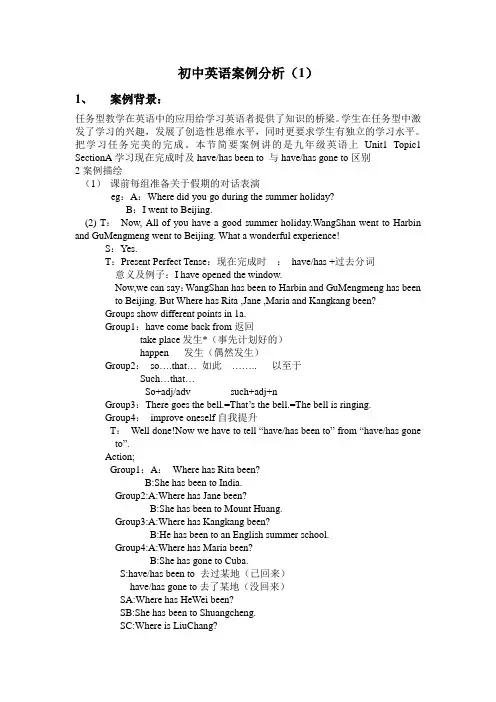
初中英语案例分析(1)1、案例背景:任务型教学在英语中的应用给学习英语者提供了知识的桥梁。
学生在任务型中激发了学习的兴趣,发展了创造性思维水平,同时更要求学生有独立的学习水平。
把学习任务完美的完成。
本节简要案例讲的是九年级英语上Unit1 Topic1 SectionA学习现在完成时及have/has been to 与have/has gone to区别2案例描绘(1)课前每组准备关于假期的对话表演eg:A:Where did you go during the summer holiday?B:I went to Beijing.(2) T:Now, All of you have a good summer holiday.WangShan went to Harbin and GuMengmeng went to Beijing. What a wonderful experience!S:Yes.T:Present Perfect Tense:现在完成时:have/has +过去分词意义及例子:I have opened the window.Now,we can say:WangShan has been to Harbin and GuMengmeng has beento Beijing. But Where has Rita ,Jane ,Maria and Kangkang been?Groups show different points in 1a.Group1:have come back from返回take place发生*(事先计划好的)happen 发生(偶然发生)Group2:so….that…如此…….. 以至于Such…that…So+adj/adv such+adj+nGroup3:There goes the bell.=That’s the bell.=The bell is ringing.Group4:improve oneself自我提升T:Well done!Now we have to tell “have/has been to” from “have/has goneto”.Action;Group1:A:Where has Rita been?B:She has been to India.Group2:A:Where has Jane been?B:She has been to Mount Huang.Group3:A:Where has Kangkang been?B:He has been to an English summer school.Group4:A:Where has Maria been?B:She has gone to Cuba.S:have/has been to 去过某地(已回来)have/has gone to去了某地(没回来)SA:Where has HeWei been?SB:She has been to Shuangcheng.SC:Where is LiuChang?SD:She has gone to the teacher’s office.SE:When will she come back?SF:She will come back in five minutes.Finish 2in Groups.Homework: The differences between the simple past tense and present perfect tense. 案例评析:任务型教学目的让学生脱离教材,在乐中学,有任务而学习。

初中英语作文题目案例分析1、以My Best Friend and I为题写一篇短文,比较你俩的特征。
提示:1. 我的好友名叫琳达;2. 在某些方面,我们看上去一样;在某些方面,我们看起来不同;3. 我们都有黑眼睛,黑头发;4. 她比我高,比我文静,很认真;5. 我外向一点,而且比她风趣;6. 都喜欢读书。
要求:1. 条理清楚,语句通顺,语法正确,书写规范;2. 不少于60词。
My Best Friend and ILinda is my best friend. We are like each other very much. We both have big eyes, black hair. And both of us like reading books. But we are also different from each other in many places. She is taller than me. She is quieter and more careful than me. I am more humor than her.在你的成长过程中,父亲会给你的一生带来很大的影响,请根据表格中的提示向读者介绍你的父亲,具体要求如下:注意:1.要点齐全,而且有适当拓展,但不得逐字翻译;2.条理清晰,语意连贯,字迹工整。
3.词数90 左右。
My father has influenced me a lot since I was born.He is in his fifties. He is neither too tall nor too short and has a lot of interests, especially reading. Red is his favorite color because it represents power and strong feelings.It can make him more powerful. He is energetic and organized. He also has a heart full of love.He is very helpful, He often helps the children who have lost their parents.He takes good care of me and can listen to my worries and happiness patiently.I think he is not only my good teacher but also my good friend. I love him very much.1.节约资源,保护环境,践行“双创”,从我们身边的小事做起。
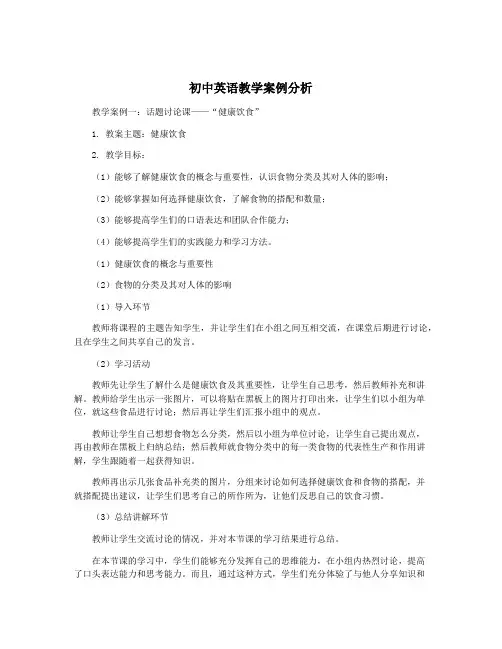
初中英语教学案例分析
教学案例一:话题讨论课——“健康饮食”
1. 教案主题:健康饮食
2. 教学目标:
(1)能够了解健康饮食的概念与重要性,认识食物分类及其对人体的影响;
(2)能够掌握如何选择健康饮食,了解食物的搭配和数量;
(3)能够提高学生们的口语表达和团队合作能力;
(4)能够提高学生们的实践能力和学习方法。
(1)健康饮食的概念与重要性
(2)食物的分类及其对人体的影响
(1)导入环节
教师将课程的主题告知学生,并让学生们在小组之间互相交流,在课堂后期进行讨论,且在学生之间共享自己的发言。
(2)学习活动
教师先让学生了解什么是健康饮食及其重要性,让学生自己思考,然后教师补充和讲解。
教师给学生出示一张图片,可以将贴在黑板上的图片打印出来,让学生们以小组为单位,就这些食品进行讨论;然后再让学生们汇报小组中的观点。
教师让学生自己想想食物怎么分类,然后以小组为单位讨论,让学生自己提出观点,
再由教师在黑板上归纳总结;然后教师就食物分类中的每一类食物的代表性生产和作用讲解,学生跟随着一起获得知识。
教师再出示几张食品补充类的图片,分组来讨论如何选择健康饮食和食物的搭配,并
就搭配提出建议,让学生们思考自己的所作所为,让他们反思自己的饮食习惯。
(3)总结讲解环节
教师让学生交流讨论的情况,并对本节课的学习结果进行总结。
在本节课的学习中,学生们能够充分发挥自己的思维能力,在小组内热烈讨论,提高
了口头表达能力和思考能力。
而且,通过这种方式,学生们充分体验了与他人分享知识和
团队协作的乐趣。
此外,教师通过提出具体的例子和实际操练了学生们的实践能力和解决问题的能力。
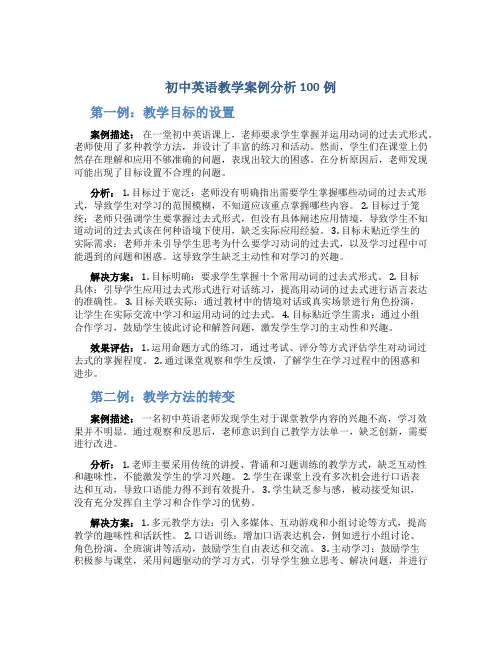
初中英语教学案例分析100例第一例:教学目标的设置案例描述:在一堂初中英语课上,老师要求学生掌握并运用动词的过去式形式。
老师使用了多种教学方法,并设计了丰富的练习和活动。
然而,学生们在课堂上仍然存在理解和应用不够准确的问题,表现出较大的困惑。
在分析原因后,老师发现可能出现了目标设置不合理的问题。
分析: 1. 目标过于宽泛:老师没有明确指出需要学生掌握哪些动词的过去式形式,导致学生对学习的范围模糊,不知道应该重点掌握哪些内容。
2. 目标过于笼统:老师只强调学生要掌握过去式形式,但没有具体阐述应用情境,导致学生不知道动词的过去式该在何种语境下使用,缺乏实际应用经验。
3. 目标未贴近学生的实际需求:老师并未引导学生思考为什么要学习动词的过去式,以及学习过程中可能遇到的问题和困惑。
这导致学生缺乏主动性和对学习的兴趣。
解决方案: 1. 目标明确:要求学生掌握十个常用动词的过去式形式。
2. 目标具体:引导学生应用过去式形式进行对话练习,提高用动词的过去式进行语言表达的准确性。
3. 目标关联实际:通过教材中的情境对话或真实场景进行角色扮演,让学生在实际交流中学习和运用动词的过去式。
4. 目标贴近学生需求:通过小组合作学习,鼓励学生彼此讨论和解答问题,激发学生学习的主动性和兴趣。
效果评估: 1. 运用命题方式的练习,通过考试、评分等方式评估学生对动词过去式的掌握程度。
2. 通过课堂观察和学生反馈,了解学生在学习过程中的困惑和进步。
第二例:教学方法的转变案例描述:一名初中英语老师发现学生对于课堂教学内容的兴趣不高,学习效果并不明显。
通过观察和反思后,老师意识到自己教学方法单一,缺乏创新,需要进行改进。
分析: 1. 老师主要采用传统的讲授、背诵和习题训练的教学方式,缺乏互动性和趣味性,不能激发学生的学习兴趣。
2. 学生在课堂上没有多次机会进行口语表达和互动,导致口语能力得不到有效提升。
3. 学生缺乏参与感,被动接受知识,没有充分发挥自主学习和合作学习的优势。
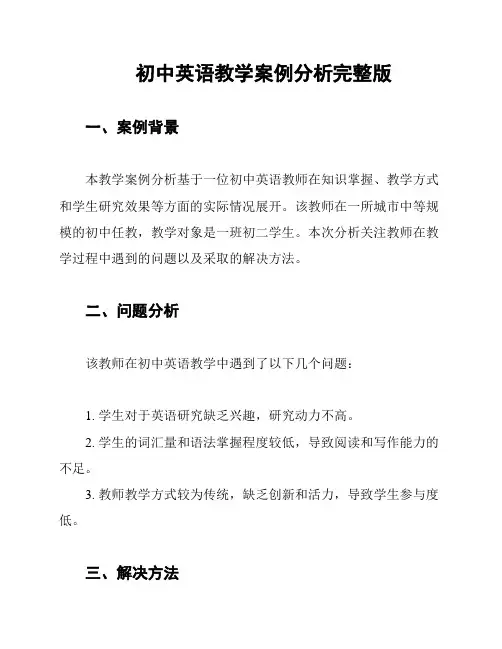
初中英语教学案例分析完整版一、案例背景本教学案例分析基于一位初中英语教师在知识掌握、教学方式和学生研究效果等方面的实际情况展开。
该教师在一所城市中等规模的初中任教,教学对象是一班初二学生。
本次分析关注教师在教学过程中遇到的问题以及采取的解决方法。
二、问题分析该教师在初中英语教学中遇到了以下几个问题:1. 学生对于英语研究缺乏兴趣,研究动力不高。
2. 学生的词汇量和语法掌握程度较低,导致阅读和写作能力的不足。
3. 教师教学方式较为传统,缺乏创新和活力,导致学生参与度低。
三、解决方法1. 激发学生研究兴趣教师采取以下措施激发学生研究兴趣:- 创设情境:通过引入与学生生活相关的话题和实际情境,增加研究的实用性和可操作性。
- 游戏化研究:利用游戏和竞赛等方式,增加学生研究英语的趣味性和竞争性。
- 多媒体辅助:利用多媒体技术,如音频和视频等,让学生在听、说、读、写等方面更加互动和享受研究过程。
2. 提升学生词汇量和语法掌握程度教师采取以下措施提升学生的词汇量和语法掌握程度:- 多读多写:鼓励学生多读英文原著、英语文章,并写作练,以提升词汇量和语法运用能力。
- 创设语境:通过真实场景和情境,帮助学生理解和掌握常用词汇和语法知识,加强实际运用。
- 梳理重难点:针对学生普遍存在的难点,有针对性地进行讲解和练,提高学生的词汇积累和语法掌握能力。
3.注重教学方式创新教师采取以下措施创学方式:- 小组合作研究:鼓励学生自主合作,通过小组合作研究,增加学生的互动和表达机会。
- 情景教学:利用真实情境,让学生在情景中理解和运用英语知识,提高研究效果。
- 全英文教学:增加英文语言输入,提高学生的听说能力和语言环境适应能力。
四、效果评估通过以上解决方法的实施,教师反馈以下效果:1. 学生对英语研究的兴趣明显增加,积极参与课堂活动。
2. 学生的词汇量和语法掌握程度得到明显提升,阅读和写作能力有明显改善。
3. 教学方式创新带来的学生参与度和表达能力明显提高。
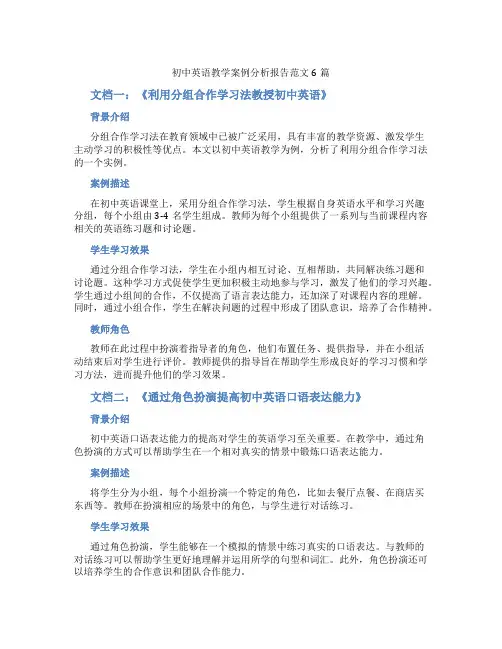
初中英语教学案例分析报告范文6篇文档一:《利用分组合作学习法教授初中英语》背景介绍分组合作学习法在教育领域中已被广泛采用,具有丰富的教学资源、激发学生主动学习的积极性等优点。
本文以初中英语教学为例,分析了利用分组合作学习法的一个实例。
案例描述在初中英语课堂上,采用分组合作学习法,学生根据自身英语水平和学习兴趣分组,每个小组由3-4名学生组成。
教师为每个小组提供了一系列与当前课程内容相关的英语练习题和讨论题。
学生学习效果通过分组合作学习法,学生在小组内相互讨论、互相帮助,共同解决练习题和讨论题。
这种学习方式促使学生更加积极主动地参与学习,激发了他们的学习兴趣。
学生通过小组间的合作,不仅提高了语言表达能力,还加深了对课程内容的理解。
同时,通过小组合作,学生在解决问题的过程中形成了团队意识,培养了合作精神。
教师角色教师在此过程中扮演着指导者的角色,他们布置任务、提供指导,并在小组活动结束后对学生进行评价。
教师提供的指导旨在帮助学生形成良好的学习习惯和学习方法,进而提升他们的学习效果。
文档二:《通过角色扮演提高初中英语口语表达能力》背景介绍初中英语口语表达能力的提高对学生的英语学习至关重要。
在教学中,通过角色扮演的方式可以帮助学生在一个相对真实的情景中锻炼口语表达能力。
案例描述将学生分为小组,每个小组扮演一个特定的角色,比如去餐厅点餐、在商店买东西等。
教师在扮演相应的场景中的角色,与学生进行对话练习。
学生学习效果通过角色扮演,学生能够在一个模拟的情景中练习真实的口语表达。
与教师的对话练习可以帮助学生更好地理解并运用所学的句型和词汇。
此外,角色扮演还可以培养学生的合作意识和团队合作能力。
教师在角色扮演中既是引导者,也是参与者。
他们需要起到积极引导学生参与角色扮演的作用,并及时给予学生反馈和指导。
教师还可以在角色扮演活动结束后进行整体的总结和评价。
文档三:《利用多媒体教具提高初中英语听力能力》背景介绍初中英语听力是学生英语学习中的重要环节。
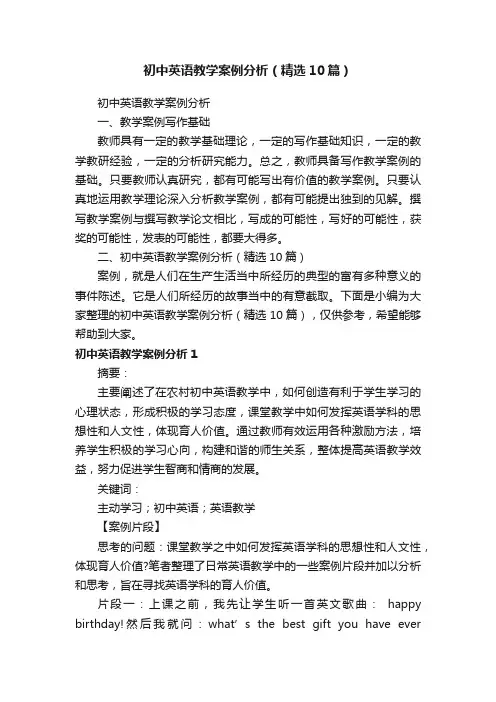
初中英语教学案例分析(精选10篇)初中英语教学案例分析一、教学案例写作基础教师具有一定的教学基础理论,一定的写作基础知识,一定的教学教研经验,一定的分析研究能力。
总之,教师具备写作教学案例的基础。
只要教师认真研究,都有可能写出有价值的教学案例。
只要认真地运用教学理论深入分析教学案例,都有可能提出独到的见解。
撰写教学案例与撰写教学论文相比,写成的可能性,写好的可能性,获奖的可能性,发表的可能性,都要大得多。
二、初中英语教学案例分析(精选10篇)案例,就是人们在生产生活当中所经历的典型的富有多种意义的事件陈述。
它是人们所经历的故事当中的有意截取。
下面是小编为大家整理的初中英语教学案例分析(精选10篇),仅供参考,希望能够帮助到大家。
初中英语教学案例分析1摘要:主要阐述了在农村初中英语教学中,如何创造有利于学生学习的心理状态,形成积极的学习态度,课堂教学中如何发挥英语学科的思想性和人文性,体现育人价值。
通过教师有效运用各种激励方法,培养学生积极的学习心向,构建和谐的师生关系,整体提高英语教学效益,努力促进学生智商和情商的发展。
关键词:主动学习;初中英语;英语教学【案例片段】思考的问题:课堂教学之中如何发挥英语学科的思想性和人文性,体现育人价值?笔者整理了日常英语教学中的一些案例片段并加以分析和思考,旨在寻找英语学科的育人价值。
片段一:上课之前,我先让学生听一首英文歌曲:happy birthday!然后我就问:what’s the best gift you have everreceived?when did you get it?who gave it to you?片段二:学生个个热情高涨,发表自己的看法。
请大家谈谈应该送什么礼物给自己的同学和朋友,庆祝生日,并相互评价,是否合理。
片段三:我布置的家庭作业,是学生回家以后,调查家里人的生日:what should i get my father/mother?what about…why don’t you…【教学反思】关于生日礼物,大多数学生都很清楚,但是应该送什么礼物,多数学生没有思考过这一问题,教师有意让学生进行思考和讨论。
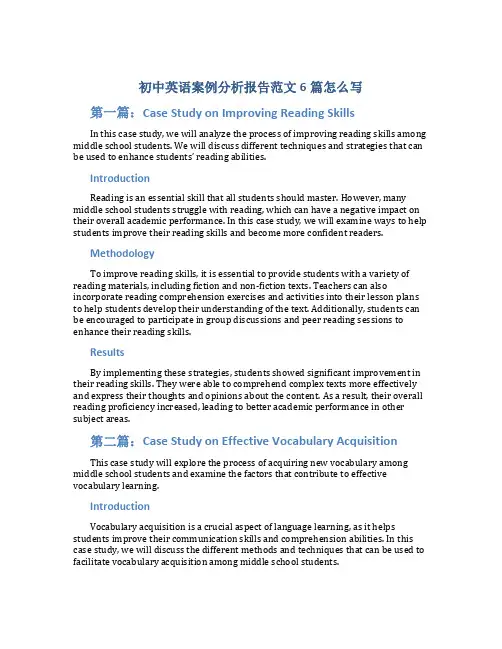
初中英语案例分析报告范文6篇怎么写第一篇:Case Study on Improving Reading SkillsIn this case study, we will analyze the process of improving reading skills among middle school students. We will discuss different techniques and strategies that can be used to enhance students’ reading abilities.IntroductionReading is an essential skill that all students should master. However, many middle school students struggle with reading, which can have a negative impact on their overall academic performance. In this case study, we will examine ways to help students improve their reading skills and become more confident readers.MethodologyTo improve reading skills, it is essential to provide students with a variety of reading materials, including fiction and non-fiction texts. Teachers can also incorporate reading comprehension exercises and activities into their lesson plans to help students develop their understanding of the text. Additionally, students can be encouraged to participate in group discussions and peer reading sessions to enhance their reading skills.ResultsBy implementing these strategies, students showed significant improvement in their reading skills. They were able to comprehend complex texts more effectively and express their thoughts and opinions about the content. As a result, their overall reading proficiency increased, leading to better academic performance in other subject areas.第二篇:Case Study on Effective Vocabulary AcquisitionThis case study will explore the process of acquiring new vocabulary among middle school students and examine the factors that contribute to effective vocabulary learning.IntroductionVocabulary acquisition is a crucial aspect of language learning, as it helps students improve their communication skills and comprehension abilities. In this case study, we will discuss the different methods and techniques that can be used to facilitate vocabulary acquisition among middle school students.MethodologyTo enhance vocabulary acquisition, teachers can introduce students to new words through context-based learning activities, such as reading passages or watching videos. Students can also be encouraged to create flashcards or engage in vocabulary games to reinforce their understanding of the new words. Additionally, regular vocabulary quizzes and assessments can be used to track students’ progress and identify areas for improvement.ResultsThrough the implementation of these strategies, students demonstrated a significant improvement in their vocabulary acquisition. They were able to recall and use new words in context, leading to enhanced communication skills and overall language proficiency.第三篇:Case Study on Developing Writing SkillsIn this case study, we will analyze the process of developing writing skills among middle school students and explore effective strategies for improving students’ writing abil ities.IntroductionWriting is a fundamental skill that allows students to express their thoughts and ideas effectively. In this case study, we will discuss the different techniques and methods that can be used to help students enhance their writing skills and become more proficient writers.MethodologyTo develop writing skills, teachers can provide students with writing prompts and assignments that encourage them to explore different genres and styles of writing. Students can also be encouraged to participate in peer reviewing sessions to receive feedback on their writing and improve their editing skills. Additionally, teachers can provide individualized guidance and support to help students develop their writing skills at their own pace.ResultsBy implementing these strategies, students showed significant improvement in their writing skills. They were able to write more cohesively and fluently, demonstrating a greater understanding of grammar and sentence structure. As a result, their writing proficiency improved, leading to better academic performance in language arts and other subject areas.第四篇:Case Study on Effective Listening SkillsThis case study will examine the process of developing effective listening skills among middle school students and explo re strategies for improving students’ listening abilities.IntroductionListening is a critical skill that plays a key role in communication and language learning. In this case study, we will discuss the importance of developing effective listening skills and explore techniques that can be used to help students become better listeners.MethodologyTo enhance listening skills, teachers can incorporate listening activities and exercises into their lesson plans, such as listening to audio recordings or watching videos. Students can also be encouraged to participate in group discussions and oral presentations to practice active listening and improve their comprehension skills. Additionally, teachers can provide students with opportunities to listen to a variety of accents and speech patterns to enhance their listening proficiency.ResultsThrough the implementation of these strategies, students demonstrated a significant improvement in their listening skills. They were able to follow instructions more effectively, retain information from lectures and presentations, and engage in meaningful conversations with their peers. As a result, their overall listening proficiency increased, leading to better communication skills and academic performance.第五篇:Case Study on Enhancing Speaking SkillsIn this case study, we will analyze the process of enhancing speaking skills among middle school students and explore effective strategies for improving students’ oral communication abilities.IntroductionSpeaking is a crucial aspect of language learning that allows students to express themselves and communicate with others. In this case study, we will discuss the different techniques and methods that can be used to help students enhance their speaking skills and become more confident speakers.MethodologyTo enhance speaking skills, teachers can provide students with opportunities to practice speaking in a variety of contexts, such as debates, presentations, and role-playing activities. Students can also be encouraged to engage in group discussions and peer speaking sessions to improve their conversational skills. Additionally, teachers can provide constructive feedback and guidance to help students overcome their speaking challenges and build confidence in their speaking abilities.ResultsBy implementing these strategies, students showed significant improvement in their speaking skills. They were able to articulate their thoughts and ideas more clearly, participate actively in class discussions, and deliver engaging presentations. As a result, their oral communication skills improved, leading to better interaction with their peers and increased confidence in speaking English.第六篇:Case Study on Integrated Language Skills DevelopmentThis case study will explore the process of integrating the four language skills –reading, writing, listening, and speaking – to enhance overall language proficiency among middle school students.IntroductionLanguage learning involves the development of multiple skills, including reading, writing, listening, and speaking. In this case study, we will discuss the importance of integrating these language skills and explore strategies that can be used to promote comprehensive language development among students.MethodologyTo integrate language skills, teachers can design interdisciplinary lesson plans that incorporate reading, writing, listening, and speaking activities. Students can be encouraged to work on projects that require them to use all four language skills, such as creating multimedia presentations or conducting debates. Additionally, teachers can provide students with opportunities to practice integrated language skills in real-life situations to enhance their language proficiency.ResultsThrough the implementation of these strategies, students demonstrated a significant improvement in their overall language proficiency. They were able to apply their reading, writing, listening, and speaking skills in a variety of contexts, leading to enhanced communication abilities and academic performance. As a result, students became more confident and proficient in using English for academic and everyday purposes.以上为初中英语案例分析报告范文6篇的文档内容,希望对您撰写相关报告提供帮助。
初中英语案例分析篇一:Case No. 001Case Study: Midterm ResultsSubject: EnglishGrade: Junior HighKeywords: improvement, strategy, individual needsBackground:In a junior high school class, the English teacher noticed that most students had scored below average in their midterm exams. Concerned about their progress, the teacher decided to analyze the situation and develop effective strategies to improve the students' performance.Analysis:1. Identifying the difficulties:2. Individual needs:Knowing that students have different learning styles and abilities, the teacher decided to create a personalized learning plan for each student. This would enable them to focus on their specific areas of weakness.3. Vocabulary and grammar:To improve vocabulary and grammar skills, the teacherdecided to assign regular vocabulary quizzes and grammar exercises. She also introduced a daily vocabulary practice routine, where students had to learn and use five new wordsevery day.5. Writing:To enhance writing skills, the teacher decided to introducea weekly writing task. Each student had to write a short paragraph on a given topic, and the teacher would provide feedback and suggestions for improvement. In addition, she encouraged students to keep a daily journal to practice writing regularly.6. Monitoring progress:The teacher decided to monitor the students' progressclosely by conducting regular assessments. This would help her identify whether the strategies implemented were effective and make any necessary adjustments.Results:Conclusion:By identifying the difficulties, addressing individual needs, and implementing effective strategies, the English teacher managed to improve the students' performance in the subject.This case study highlights the importance of personalizedlearning plans and regular practice in enhancing students' English language proficiency.。
初中英语教学案例分析一、案例简介在初中英语教学中,教师面临着来自不同学生的各种教学挑战。
本文将针对某一实际教学案例展开分析,以期深入探讨如何更好地应对教学中遇到的问题,并提出解决方案。
二、案例分析某初中九年级英语班级中,有一位叫小明的学生英语成绩一直较差,尤其是在英语听力方面。
在课堂上,小明总是听不清楚老师的发音,也无法完全理解教师的英语口语表达。
在课后作业中,小明的口语表达和写作能力又相对较弱,总是出现语法错误和用词不当的问题。
针对这一案例,教师需要仔细分析问题的原因,以制定有效的教学策略。
1. 听力问题:小明可能存在听力方面的困难,这可能是由于他在英语学习初期没有进行充分的英语听力训练,导致对英语语音和语调的掌握不够准确。
也可能是由于小明在平时生活中对英语听力的接触较少,导致对于英语口语的理解存在障碍。
2. 口语表达和写作问题:小明的口语表达和写作能力较弱,可能是由于他在语法和词汇方面的掌握不够扎实,同时也可能是由于他缺乏练习的机会。
三、解决方案针对小明的问题,教师可以采取以下解决方案:1. 加强听力训练:教师可以通过多媒体设备或者英语听力教材,为小明提供更多的听力训练机会。
在课堂上也可以采取听力练习的形式,让小明在积极的氛围中进行英语听力练习,提高他的听力水平。
2. 提供口语和写作练习:教师可以设计口语和写作练习,让小明积极参与,提高他的口语表达和写作能力。
教师也可以为小明提供更多关于语法和词汇掌握的帮助,让他的语言基础更加扎实。
3. 鼓励学生参与:教师在课堂上可以鼓励小明积极参与英语讨论和交流,给予他更多的表扬和鼓励,让他在英语学习中充满自信,提高学习积极性。
四、效果评估经过一段时间的教学实践,教师可以对小明的学习情况进行评估,以了解教学效果。
1. 听力提高:通过观察小明的听力训练练习和课堂表现,教师可以判断小明的听力是否有所提高。
可以通过听力测试等形式来进行客观评估。
2. 口语表达和写作提高:通过小明的口语表达和写作练习,教师可以了解小明在口语和写作方面是否有所改善。
初中英语教学典型案例分析What things can harm the environment?(What do you think we should do to improve our environment? )活动目的:通过列举污染源,学生更清楚当前环境的不仅如人意,保护环境刻不容缓,从而使学生增强保护环境的意识。
他们动脑筋,想办法,积极讨论保护环境的措施,在不知不觉中提高英语语言运用能力。
活动过程:T: There is much pollution all over the world now. Can you tell me what it is?( 学生很快地回答 )Ss: Water pollution ; Air pollution; Noise pollution; soil poll ution … etc.T: Do you know what causes water pollution?Ss: Factories pour waste water into rivers and lakes.T: All the factories?Ss: No.T: What factories?Ss: Paper factories, printing and dyeing m ills, plastic factories … ect. ( 学生不会用英语说“印染厂及塑料厂”,他们说中文,我说英文。
)T: What else can cause water pollution, too?Ss: Some people throw rubbish into rivers and lakes.T: How can we help to solve this problem?( 学生们分组讨论解决办法。
)Ss: We can advise the directors of these factories to stop pouring waste water into rivers and lakes.T: If they don ' t accept your advice ,what else can we do?(学生们讨论更热烈了,过了一会儿,他们七嘴八舌地说:)Ss: 1. We can write a letter to Green China about it.2. We can also ask newspaper reporters and TV station reporters to report these factories. ……T: There is a paper factory in my hometown .It pours waste water into the river every day. The people in the town drink the water of the river every day. They have advise the leader to stop pouring waste water into the river many times .But he never accepts it. Can you write a letter about it to the Green China?( 学生异口同声说“ Yes ”。
第1篇一、背景随着新课程改革的深入推进,英语教学不再仅仅是语言知识的传授,更是培养学生英语核心素养的过程。
初中英语教研组作为学校英语教学的重要组织,肩负着引领教学方向、提升教学质量的重任。
本案例以某初中英语教研组为单位,探讨如何基于核心素养,进行单元整体教学设计与实施。
二、案例描述1. 问题提出在某初中英语教研组的教学研讨会上,教师们普遍反映学生在英语学习中存在以下问题:(1)缺乏对英语学习的兴趣和动力;(2)英语听说读写能力发展不均衡;(3)英语学习缺乏系统性,难以形成完整的知识体系。
针对以上问题,教研组决定以单元整体教学设计为切入点,探索提升学生英语核心素养的有效途径。
2. 单元选择与主题确定教研组首先分析了教材内容和学生实际情况,确定了以“人与自我”为主题,选取了人教版初中英语教材九年级上册Unit 5 Do you want to watch a movie? 为教学单元。
3. 单元教学目标根据核心素养的要求,教研组确立了以下单元教学目标:(1)知识目标:掌握单元词汇、语法和句型;(2)能力目标:提高听、说、读、写四项技能;(3)情感目标:培养学生热爱生活、积极向上的情感态度。
4. 单元教学设计(1)导入环节教师通过图片、视频等多媒体手段,展示电影主题,激发学生学习兴趣。
同时,引导学生回顾已学知识,为新课学习做好铺垫。
(2)新课教授教师按照以下步骤进行新课教授:①词汇教学:通过实物、图片、情景等多种方式,帮助学生理解和记忆词汇;②语法教学:结合语境,讲解语法知识,并通过练习巩固;③听说教学:设计听、说活动,如角色扮演、小组讨论等,提高学生的听说能力;④读写教学:通过阅读课文、完成写作任务,培养学生的阅读和写作能力。
(3)拓展延伸教师引导学生进行以下拓展活动:①观看英文电影片段,提高英语听说能力;②撰写影评,提高写作能力;③组织英语角活动,加强学生之间的交流。
5. 教学评价教研组采用多元化评价方式,包括:(1)课堂表现评价:观察学生在课堂上的参与度、合作意识等;(2)作业评价:检查学生完成作业的情况,了解学生对知识的掌握程度;(3)测试评价:定期进行单元测试,评估学生的学习成果。
初中英语教学案例分析本教学案例主题为初中英语课的“感官词汇”教学。
通过该教学案例,将向读者展示如何注重词汇教学,以不同的感官方式来帮助学生掌握英语词汇。
一、教学目标1. 学习和使用感官描述词汇。
2. 了解感官词汇的不同用法和场景。
3. 通过听、说、读、写的综合训练,提高学生英语综合应用能力。
二、教学背景学生:初一学生,大部分没有留学背景,学习英语时间较短。
教材:广州版初一英语(下)第三单元。
任务:学习和运用感官相关的英语词汇。
三、教学过程1. 导入上课前,老师准备了一些图片和香水、口香糖、巧克力等食物,并招呼两位同学前来帮忙。
老师拿出第一张图片,要求两位同学蒙上眼睛,然后让他们通过不同的方式“感受”图片所代表的场景,比如“看到阳光自然很亮,天空很蓝”,让学生使用视觉感官的词汇。
接着,老师给两位同学各一瓶香水,让他们描述出香水的特点,引导学生使用嗅觉感官的词汇。
接下来,老师让两位同学吃一块巧克力和一颗口香糖,让他们口中品尝后用味觉感官的词汇描述出来。
最后,让两位同学摸一些不同的材料(如棉花、砂纸、泥土等)来使用触觉感官的词汇描述它们的质感。
通过这种方式,老师帮助学生熟悉了感官描述的常用词汇,为后面的词汇学习打下基础。
2. 词汇学习接下来,老师将学生分成小组,在每个小组中发放一份词汇表,该词汇表上列出了与感官有关的英语词汇,并安排每个组员阅读词汇表上的单词,了解其含义和用法。
每个小组中有一个学生要担任发言人,其余组员可以向他/她咨询单词的含义和用法。
每个小组都有10分钟的时间准备,并完成学习任务。
学生们可以使用彼此的课本和词典来解决问题。
当所有的小组完成任务后,老师将全班分成两组,并让每组的发言人把他们所学的词汇向其他同学介绍一遍。
老师在这个环节督促学生们互相交流词汇知识,帮助他们加深记忆,提高理解。
在此后的学习过程中,老师通过课堂讲解和学生听、说、读、写的训练,帮助学生更好地掌握和使用感官词汇。
3. 听力训练接下来,老师播放一段短视频,让学生听取其中的感官描述词汇。
初中英语阅读课教学案例分析范文6篇English:In analyzing teaching cases for junior high school English reading classes, it's essential to consider various factors such as student proficiency levels, text complexity, teaching objectives, and instructional strategies. For instance, when selecting texts, teachers should choose materials that align with students' language proficiency and interests while offering opportunities for linguistic and cognitive growth. Furthermore, effective lesson planning involves incorporating pre-reading activities to activate prior knowledge, during-reading tasks to scaffold comprehension, and post-reading activities to reinforce learning outcomes. Teachers should also employ a variety of instructional techniques, such as think-alouds, reciprocal teaching, and graphic organizers, to cater to diverse learning styles and promote active engagement. Additionally, assessment strategies should encompass both formative and summative methods, including informal checks for understanding during class and more formal assessments like quizzes or projects to evaluate comprehension and language development over time. By carefully analyzing these components and adapting instruction tomeet students' needs, teachers can create enriching learning experiences that foster both language proficiency and critical thinking skills.中文翻译:在分析初中英语阅读课教学案例时,必须考虑各种因素,如学生的水平、文本复杂度、教学目标和教学策略。
初中英语案例分析【背景】任务型教学《英语课程标准》明确提出:“ 教师应尽量避免单纯传授语言知识的教学方法,尽量采用‘ 任务型 ' 的教学途径” 。
让学生用英语完成各种真实的生活、学习、工作等任务(即做各种各样的事情),活动要以学生的生活经验和兴趣为出发点,内容和方式要尽量真实。
教师应依据课程的总体目标并结合教学内容,创造性地设计贴近学生实际的教学活动,吸引和组织他们积极参与。
学生通过思考、调查、讨论、交流和合作等方式,学习和使用英语,完成学习任务从而培养学生运用英语的能力(即用英语做事的能力)。
在设计“ 任务型” 教学时应注意1 )活动要有明确的目的并具有可操作性 2)活动要以学生的生活经验和兴趣为出发点,内容和方式要尽量真实 4 )活动应积极促进英语学科和其他学科间的相互渗透和联系,使学生的思维和想象力、审美情趣和艺术感受、协作和创新精神等综合素质得到发展 5 )活动要能够促使学生获取、处理和使用信息,用英语与他人交流,发展用英语解决实际问题的能力教师应依据课程的总体目标并结合教学内容,创造性地设计贴近学生实际的教学活动,吸引和组织他们积极参与。
学生通过思考、调查、讨论、交流和合作等方式,学习和使用英语,完成学习任务。
这课通过列举污染源,学生更清楚当前环境的不仅如人意,保护环境刻不容缓,从而使学生增强保护环境的意识。
他们动脑筋,想办法,积极讨论保护环境的措施,在不知不觉中提高英语语言运用能力。
【描述】T: what does “environment” mean?Ss: It means the place where people , animals and plants live.T: When we talk about the environment, what words will first come to your mind?Ss: PollutionT: Yes. there is much pollution all over the world now . Can you tell me what it is ?(学生很快地回答)Ss: Water pollution ; Air pollution; Noise pollution;soilpollution …etc.T: Do you know what causes water pollution ?Ss: Factories pour waste water into rivers and lakes .T: What else can cause water pollution ,too?Ss: Some people throw rubbish into rivers and lakes .T: How can we help to solve this problem ?( 学生们分组讨论解决办法。
)Ss: We can advise the directors of these factories to stop pouring waste water into rivers and lakes .T: If they don’t accept your advice ,what else can we do ?(学生们讨论更热烈了,过了一会儿,他们七嘴八舌地说:)Ss:1. We can write a letter to Green China about it .2. We can also ask newspaper reporters and TV station reporters to report these factories .……T: There is a chemical factory in my hometown .It pours waste water into the river every day . They have advise the leader to stop pouring waste water into the river many times .But he never accepts it . Can you write a letter about it to the Green China ?Ss: Yes.T: Ok. It’s your homework. You have told me what causes water pollution and how to solve this problem .You’re very clever .Thank you very much .But can you tell me what causes air pollution ?Ss: The smoke of factories ,the smoke given out bybuses ,cars ,trucks ,motorbikes …ect..T: Can you think out a way to solve this problem?(学生们分组讨论解决方案,基础差的同学也纷纷参与,只不过在用中文说;基础好的同学在帮他们翻译。
)Ss: 1.We can plant more trees on roads .2.We can ask people not to drive their cars to work .3.We can ask people to ride bikes to work .4.We can tell people riding bikes is good for their health . ……T:Government should develop the public traffic. Such as adding more buses ,building underground . …ect.T: We have thought out many methods to improve our environment .I will try my best to tell our government that something must be done to make our city more beautiful .Have you ever made any pollution ?Ss: Yes .T: Can you tell me something about it ?Ss: Yes .S1: I sometimes spit in public places .S2: I sometimes draw on public walls .S3: I cut down a small tree in my school in Grade One .I feel very sorry now .S4: We sometimes throw litter on the ground in and out of our classroom . S5: I often don’t pick u p rubbish in public places .…….(我乘机问全班同学下列问题。
)T: Will you spit in public places from now on ?Ss: No.T: Will you draw on public walls any more?Ss: No.T: Will you cut down trees in the future ?Ss: No.T: Will you throw rubbish in public places?Ss: No.…….(这时候,同学们情绪很高涨,他们几乎是异口同声地说:)We must try our best to make our city (our country) the most beautiful one in the world .【评析】本案例是根据Unit 2, Module 5 The environment中的welcome to the unit 拓展而成的。
1、本文所设计的问题有明确的目的并具有可操作性。
教师让学生列举污染源,学生讲出了很多的污染源-----空气污染、水污染、土壤污染、噪音污染等等。
活动以学生的生活经验和兴趣为出发点,内容和方式真实。
加速英语与客观事物建立直接联系,增加了学生直接用英语思维习惯的培养。
同时,体现了任务型语言教学“ 在学中用,在用中学”的原则。
2、教师让学生分组讨论如何解决这些污染问题,巧妙地运用了合作学习法,不但培养了学生探究问题和自主解决问题的能力,而且也培养了学生的参政议政的意识。
同学们以主人翁的身份,提出了种种解决方法。
解决水污染问题,他们先用劝说的办法,当此法行不通时,再借助新闻媒体的力量,最后,上告政府;解决空气污染问题,他们号召人们骑车上班、乘公交车。
他们要求政府增加公交车辆,建造地铁。
3、老师因势利导,请他们回忆一下,以前有否做过有损于环保的事情。
其实是在英语课上进行德育的渗透。
在这么和谐,民主、激动的气氛中,同学们毫无顾忌,畅所欲言,纷纷讲述了自己以前的不文明表现。
当老师问他们以后还会做这种事吗?他们很真心地回答“No”。
自然恰当的德育渗透,起到一箭双雕的作用,使活动达到了高潮。
总之,整个过程,教师不是在“教教材”,而是在“用教材教”。
教师根据学生的实际情况和生活经验创造性地使用教材,从学生熟悉的知识入手,创建一个个与学生生活密切相关的问题情景,让学生带着问题思考,寻找解决问题的办法。
真正体现了《新课标》的精神----“在发展语言能力的同时,发展思维能力,激发想象力和创造力。
”《新课标》说;活动不应该仅限于课堂教学,而要延伸到课堂之外的学习和生活之中。
同学们回忆自己的不文明行为,作自我批评,是活动的高潮,是自我教育,提高环保意识的最有效手段。
当时,教师应该趁热打铁,利用同学们的这份热情,让同学们利用课余时间,用英语采访同年级的别班同学,让同学们在同龄人面前很自然地回忆自己的不文明行为。
然后,以此为依据,让本班同学用英语向全校同学发一份以“保护环境”为内容的倡议书。
这不但会在全校兴起一股学英语的热潮,还会使环保意识深入人心。
这是实实在在的任务型教学,体现了学中用,用中学的《新课标》精神。
让学生在实现任务的同时,感受成功,以形成积极的学习态度,促进英语语言实际运用能力的提高。
这才真正符合《新课标》的理念。